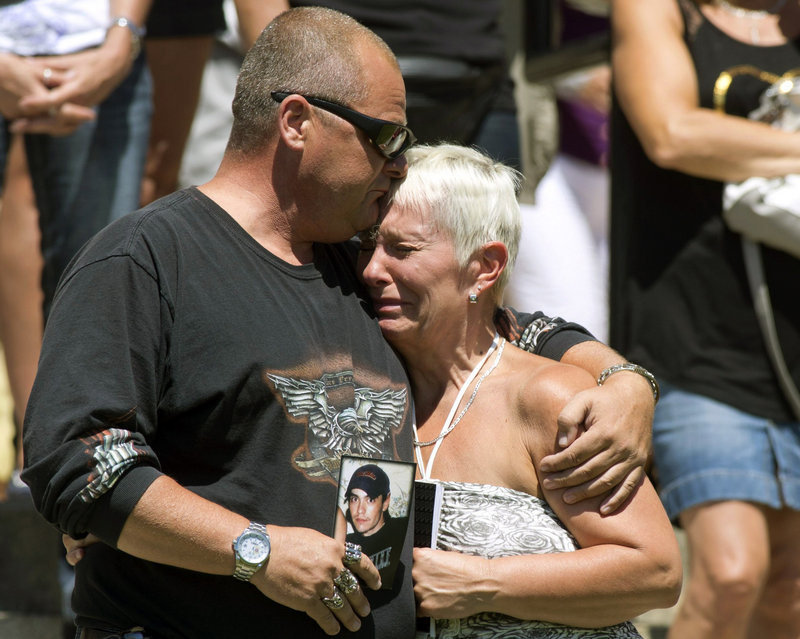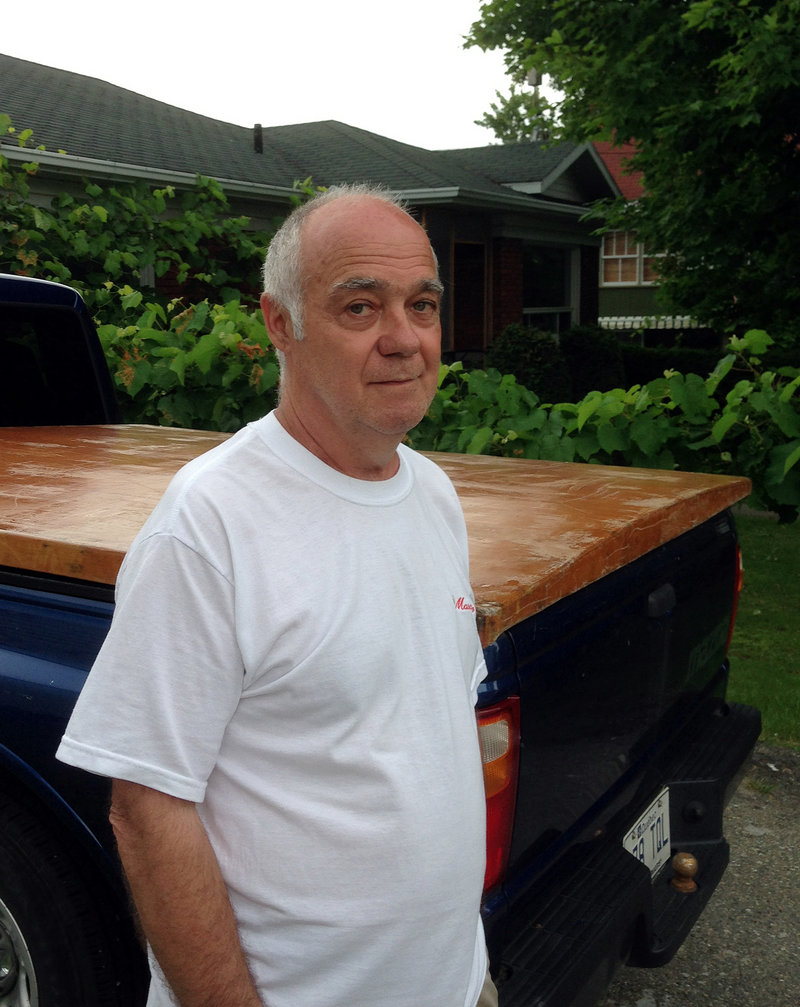LAC-MEGANTIC, Quebec – It was surely the most festive spot in town as a Friday night turned into a Saturday morning at the Musi-Cafe — a full house, live music, plenty of beer and nachos to animate longtime friends.
Among the dozens enjoying themselves in the pub was a sizable contingent of the Lafontaine clan, celebrating the 40th birthday of a daughter of prominent local businessman Raymond Lafontaine.
Four days later — having lost a son and two daughters-in-law who were among the revelers — Lafontaine stood near a throng of reporters on a street near the town center, watching them pepper an American railroad executive with questions.
“I wanted to see my children’s killer,” Lafontaine said. “And I wanted to see the killer of other people from here who didn’t ask to die.”
Any possible culpability on the part of the railway remains to be determined; police say their criminal investigation will proceed slowly and carefully. But it is fact that an unmanned Montreal, Maine and Atlantic freight train with 72 cars carrying shale oil turned into a runaway death machine — rolling away from its overnight parking spot, barreling for miles down an incline in the dark of night, derailing in the heart of Lac-Megantic at 1:14 a.m. on July 6, and snuffing out 50 lives when a series of explosions set off a ferocious fire.
For some, it became known as “the train of death.” For others in the close-knit, French-speaking town, it was “le train d’enfer” — or “the train from hell.”
Gilles Fluet, a 65-year-old retiree who used to work at a door-making factory, left the Musi-Cafe just moments before the first explosion and saw the train go by.
“It was moving at a hellish speed … no lights, no signals, nothing at all,” he said. “There was no warning. It was a black blob that came out of nowhere.”
“I realized they were oil tankers and they were going to blow up, so I yelled that to my friends and I got out of there,” he said. “If we had stayed where we were, we would have been roasted.”
Those who were still in the pub, he said, “had no chance.”
It’s daunting to ponder the toll exacted on Lac-Megantic. Fifty dead in a town of 6,000 represents nearly 1 percent of the population — a rate that high for a big city would verge on apocalyptic.
Some residents have suggested that the train disaster is comparable in its impact on their town to how the Sept. 11, 2001, terrorist attacks affected New York City. And indeed there are similarities — sudden, deadly conflagrations; victims whose virtually vaporized remains defied easy identification; the circulation of photos of the missing, posted by relatives clinging to faint hopes that somehow their loved ones might be seen alive somewhere.
In midweek, those hopes were largely dashed when Quebec police informed families that the people still listed as missing were presumed dead.
The victims included Eliane Parenteau, vivacious and gregarious at 93, who lived in one of the homes ravaged by the blaze.
“She always said she would never go to an old people’s home and she wanted to die in her house,” her son, Michel Boulanger, told the Journal de Quebec.
At the other end of the age scale, the presumed dead include the two young daughters of Talitha Coumi Begnouche — all three died in their home near the crash site. A photo of the girls, released by the family, shows them embracing — 4-year-old Alyssa with a giggly grin and 8-year-old Bianka with a soft, radiant smile.
Another victim was Guy Bolduc, a father of two children who was one of a pair of musicians performing at the Musi-Cafe. The other performer, Yvan Ricard, had taken a cigarette break outdoors when the inferno broke out, and he escaped unharmed.
“The last words he said to me were, ‘Yvan, I really like playing with you. We have so much fun together,”‘ Ricard told the television network TVA.
Among those spared by quirks of fate was the cafe’s manager, Sophie L’Heureux. She told reporters she went home around 9:30 that Friday evening, planned to return after a nap but overslept. Three of her employees are among those presumed dead, along with many of her loyal customers.
Nathalie Royer and David Isabel could have been among those doomed regulars, had it not been for home repairs they planned for later Saturday morning. The couple, both 45, left the cafe shortly after 1 a.m., with Isabel telling Royer to forgo one more drink with their friends because they had to get up early.
They decided to leave their car parked outside the bar and started to make their way home on foot. They ran when they spotted the train; Royer lost a shoe, stumbled, and suffered a burn on her arm, according to her mother, Louisette Nadeau.
“The people that died there — it’s a lot, because we’re a little town,” Nadeau said. “There’s almost none of them that we don’t know.”
The explosions and fire destroyed 30 buildings in all, including the public library that housed irreplaceable historical archives. Roughly 2,000 people — a third of the populace — were ordered to evacuate their homes, and the town’s central business district was cordoned off throughout the week, keeping out journalists and townspeople while scores of police officers and other emergency responders searched for remains of victims and sought clues to aid a criminal investigation of the crash.
Several hundred of the evacuees took shelter at the local high school, under the care of the Canadian Red Cross and other agencies.
Red Cross spokeswoman Myriam Marotte said some of the first volunteers who arrived in the middle of the night to help organize the shelter were local residents who themselves had been ordered to evacuate their homes.
“They are very dedicated,” said Marotte.
Cots arrived around 10 a.m. — nine hours after the crash — followed by an array of other supplies and services, ranging from pet care to psychological counseling.
“The most important thing was to listen to people,” Marotte said. “Not knowing what’s coming in the next hours and days is very difficult.”
Adding to the grief and shock for townspeople were the circumstances of the crash. The train was loaded with a potentially dangerous cargo, yet transport regulations allowed it to be left unattended overnight in the town of Nantes, seven miles away on a stretch of track leading downhill to the center of Lac-Megantic.
The CEO of the railway’s parent company, Ed Burkhardt, compounded local frustrations by waiting four days to visit the town and in the meantime suggesting that firefighters in Nantes may somehow have contributed to the runaway while fighting a small fire on the train late on Friday, July 5.
During a chaotic outdoor news conference Wednesday in Lac-Megantic, Burkhardt apologized, said he was devastated by the town’s calamity, and disclosed that the train’s engineer was now suspected of failing to properly apply the train’s brakes before leaving it unattended.
Raymond Lafontaine was there, watching — angry that Burkhardt hadn’t visited the town sooner.
“If a team had come to see us and said, ‘Yes, we’re here for you and there was an accident, yes, there was human error, yes, this happened,’ it seems like that would have hurt less,” Lafontaine said. “I would have been able to get through that. But this is inconceivable. I can’t accept it.”
A lakeside town in a region of rivers and gently sloped mountains in the predominantly French-speaking province, Lac-Megantic has much in common with some communities in neighboring New Hampshire and Maine — its economy encompasses a range of blue-collar industries, but it relies heavily on tourism in the summer.
The three-term mayor, Colette Roy-Laroche, maintained a confident, forward-looking tone throughout the week, urging tourists not to cancel summer reservations, assuring that the lake was safe to swim in, and expressing thanks for the support extended to her town from near and far. Britain’s Queen Elizabeth II, French President Francois Hollande and Pope Francis were among the well-wishers.
“All the messages that we’ve received give us the strength and courage to remain standing,” the mayor said.
In a signal of the town’s resilience, city officials announced that the annual “Traversee Internationale” would be held on schedule in mid-August — a five-day spectacle that includes entertainment, carnival rides and a 10-kilometer swimming competition.
“The phones are ringing,” Roy-Laroche said. “Lots of people are proposing to come visit us.”
Before then, though, will be further ordeals. A week after the crash, only a few of the bodies recovered from the rubble had been formally identified. Relatives of the victims were asked to supply combs, toothbrushes and other personal items that might help experts at a Montreal laboratory make DNA matches.
“The work is long and arduous,” said Genevieve Guilbault of the local coroner’s office.
Gilles Fluet, the retiree who left the Musi-Cafe just before the crash, was bracing for a series of funerals.
“They are my friends’ children, they’re former workmates, they’re elderly people that I know. I knew them all,” he said. “It’s as if I lost brothers, sisters, uncles — the bonds are a bit like that.”
Send questions/comments to the editors.




Comments are no longer available on this story